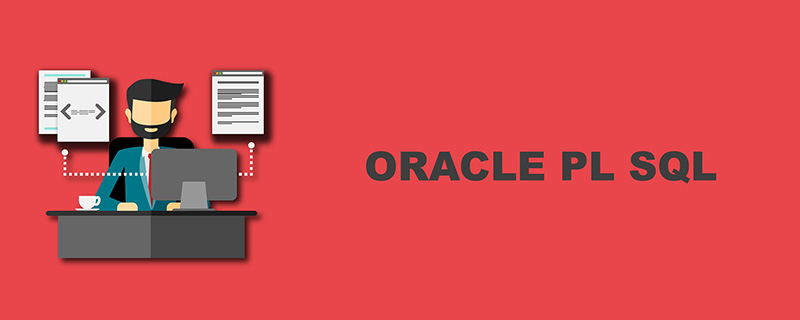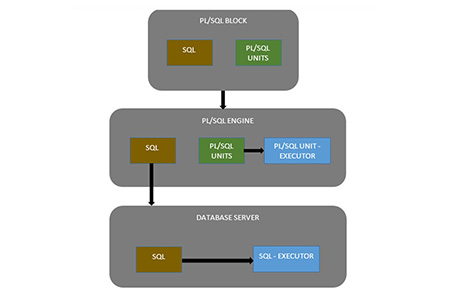What is PL/SQL? A brief introduction to PL/SQL
PL/SQL is an extension of Structured Query Language (SQL); unlike SQL, it allows programmers to write code in a procedural format. It combines the data processing capabilities of SQL with the processing capabilities of procedural languages to create super powerful SQL queries. The following article will introduce you to PL/SQL. I hope it will be helpful to everyone.

A brief introduction to PL/SQL
PL/SQL is a high-level structure ized and readable language. Its construction clearly expresses the intent of the code. Furthermore, PL/SQL is a straightforward language to learn.
PL/SQL is the standard and portable language for Oracle database development. If the program is executed on an Oracle database, it can be quickly moved to another compatible Oracle database without any changes.
PL/SQL is an embedded language. PL/SQL can only be executed in Oracle database, PL/SQL programs cannot be run on systems without Oracle database.
PL/SQL is a high-performance, highly integrated database language. In addition to PL/SQL, other programming languages such as Java, C#, and C can also be used. However, when interacting with Oracle databases, it is easier to write efficient code in PL/SQL than in other programming languages.
PL/SQL architecture
PL/SQL architecture mainly includes three components. Let’s take a brief look at them:
PL/SQL block structure
1. Block is the basic unit of programming in PL/SQL. It encapsulates a set of executable statements to complete the programmer's business needs. .
2. It includes different parts for logically dividing the code (declaration part for declaration purposes, execution part for processing statements, exception handling part for handling errors).
3. It also contains SQL instructions for interacting with the database server.
4. All PL/SQL units are considered as PL/SQL blocks, which is the initial stage of the architecture as the main input.
PL/SQL engine
1. The PL/SQL engine is the component that performs actual code processing.
2. It is responsible for compiling PL/SQL code into bytecode and executing executable code;
3. It can be installed in database servers and application servers.
4. The PL/SQL engine separates the PL/SQL unit and the SQL part in the input; the separated PL/SQL unit will be processed by the PL/SQL engine itself.
5. It will send the SQL part to the database server, where the actual interaction with the database occurs.
Note: The PL/SQL engine can only be installed in application development tools such as Oracle database server or Oracle Forms.
Database Server
1. The database server is the most important component in the Pl/SQL unit that stores data;
2. It is executed by SQL It consists of a processor that parses the input SQL statement and performs the same operation.
3. The PL/SQL engine uses SQL in the PL/SQL unit to interact with the database server.
Below is a graphical representation of the PL/SQL architecture.

Characteristics of PL/SQL
1. By executing SQL statements in batches Provides high performance not individually, thus avoiding call overhead.
2. Create complex business logic into a single program unit, thereby promoting encapsulation and productivity.
3. Integrate SQL very tightly, thereby reducing maintenance and complexity.
4. Complete portability - PL/SQL code written in one operating system can be successfully migrated to another operating system running Oracle.
5. Support high security through the encryption and decryption logic provided by Oracle's built-in software package.
6. Interaction with other programming languages.
7. Applications written in PL/SQL can be transplanted on any platform that supports Oracle.
8. Context switching overhead can be avoided by using advanced PL/SQL concepts such as batch collection and FORALL.
9. Implement object-oriented programming concepts, such as overloading.
The above is the entire content of this article, I hope it will be helpful to everyone's study. For more exciting content, you can pay attention to the relevant tutorial columns of the PHP Chinese website! ! !
The above is the detailed content of What is PL/SQL? A brief introduction to PL/SQL. For more information, please follow other related articles on the PHP Chinese website!

Hot AI Tools

Undresser.AI Undress
AI-powered app for creating realistic nude photos

AI Clothes Remover
Online AI tool for removing clothes from photos.

Undress AI Tool
Undress images for free

Clothoff.io
AI clothes remover

AI Hentai Generator
Generate AI Hentai for free.

Hot Article

Hot Tools

Notepad++7.3.1
Easy-to-use and free code editor

SublimeText3 Chinese version
Chinese version, very easy to use

Zend Studio 13.0.1
Powerful PHP integrated development environment

Dreamweaver CS6
Visual web development tools

SublimeText3 Mac version
God-level code editing software (SublimeText3)

Hot Topics
 What is the difference between HQL and SQL in Hibernate framework?
Apr 17, 2024 pm 02:57 PM
What is the difference between HQL and SQL in Hibernate framework?
Apr 17, 2024 pm 02:57 PM
HQL and SQL are compared in the Hibernate framework: HQL (1. Object-oriented syntax, 2. Database-independent queries, 3. Type safety), while SQL directly operates the database (1. Database-independent standards, 2. Complex executable queries and data manipulation).
 How does Go language implement the addition, deletion, modification and query operations of the database?
Mar 27, 2024 pm 09:39 PM
How does Go language implement the addition, deletion, modification and query operations of the database?
Mar 27, 2024 pm 09:39 PM
Go language is an efficient, concise and easy-to-learn programming language. It is favored by developers because of its advantages in concurrent programming and network programming. In actual development, database operations are an indispensable part. This article will introduce how to use Go language to implement database addition, deletion, modification and query operations. In Go language, we usually use third-party libraries to operate databases, such as commonly used sql packages, gorm, etc. Here we take the sql package as an example to introduce how to implement the addition, deletion, modification and query operations of the database. Assume we are using a MySQL database.
 Detailed tutorial on establishing a database connection using MySQLi in PHP
Jun 04, 2024 pm 01:42 PM
Detailed tutorial on establishing a database connection using MySQLi in PHP
Jun 04, 2024 pm 01:42 PM
How to use MySQLi to establish a database connection in PHP: Include MySQLi extension (require_once) Create connection function (functionconnect_to_db) Call connection function ($conn=connect_to_db()) Execute query ($result=$conn->query()) Close connection ( $conn->close())
 How does Hibernate implement polymorphic mapping?
Apr 17, 2024 pm 12:09 PM
How does Hibernate implement polymorphic mapping?
Apr 17, 2024 pm 12:09 PM
Hibernate polymorphic mapping can map inherited classes to the database and provides the following mapping types: joined-subclass: Create a separate table for the subclass, including all columns of the parent class. table-per-class: Create a separate table for subclasses, containing only subclass-specific columns. union-subclass: similar to joined-subclass, but the parent class table unions all subclass columns.
 iOS 18 adds a new 'Recovered' album function to retrieve lost or damaged photos
Jul 18, 2024 am 05:48 AM
iOS 18 adds a new 'Recovered' album function to retrieve lost or damaged photos
Jul 18, 2024 am 05:48 AM
Apple's latest releases of iOS18, iPadOS18 and macOS Sequoia systems have added an important feature to the Photos application, designed to help users easily recover photos and videos lost or damaged due to various reasons. The new feature introduces an album called "Recovered" in the Tools section of the Photos app that will automatically appear when a user has pictures or videos on their device that are not part of their photo library. The emergence of the "Recovered" album provides a solution for photos and videos lost due to database corruption, the camera application not saving to the photo library correctly, or a third-party application managing the photo library. Users only need a few simple steps
 An in-depth analysis of how HTML reads the database
Apr 09, 2024 pm 12:36 PM
An in-depth analysis of how HTML reads the database
Apr 09, 2024 pm 12:36 PM
HTML cannot read the database directly, but it can be achieved through JavaScript and AJAX. The steps include establishing a database connection, sending a query, processing the response, and updating the page. This article provides a practical example of using JavaScript, AJAX and PHP to read data from a MySQL database, showing how to dynamically display query results in an HTML page. This example uses XMLHttpRequest to establish a database connection, send a query and process the response, thereby filling data into page elements and realizing the function of HTML reading the database.
 Analysis of the basic principles of MySQL database management system
Mar 25, 2024 pm 12:42 PM
Analysis of the basic principles of MySQL database management system
Mar 25, 2024 pm 12:42 PM
Analysis of the basic principles of the MySQL database management system MySQL is a commonly used relational database management system that uses structured query language (SQL) for data storage and management. This article will introduce the basic principles of the MySQL database management system, including database creation, data table design, data addition, deletion, modification, and other operations, and provide specific code examples. 1. Database Creation In MySQL, you first need to create a database instance to store data. The following code can create a file named "my
 Tips and practices for handling Chinese garbled characters in databases with PHP
Mar 27, 2024 pm 05:21 PM
Tips and practices for handling Chinese garbled characters in databases with PHP
Mar 27, 2024 pm 05:21 PM
PHP is a back-end programming language widely used in website development. It has powerful database operation functions and is often used to interact with databases such as MySQL. However, due to the complexity of Chinese character encoding, problems often arise when dealing with Chinese garbled characters in the database. This article will introduce the skills and practices of PHP in handling Chinese garbled characters in databases, including common causes of garbled characters, solutions and specific code examples. Common reasons for garbled characters are incorrect database character set settings: the correct character set needs to be selected when creating the database, such as utf8 or u






